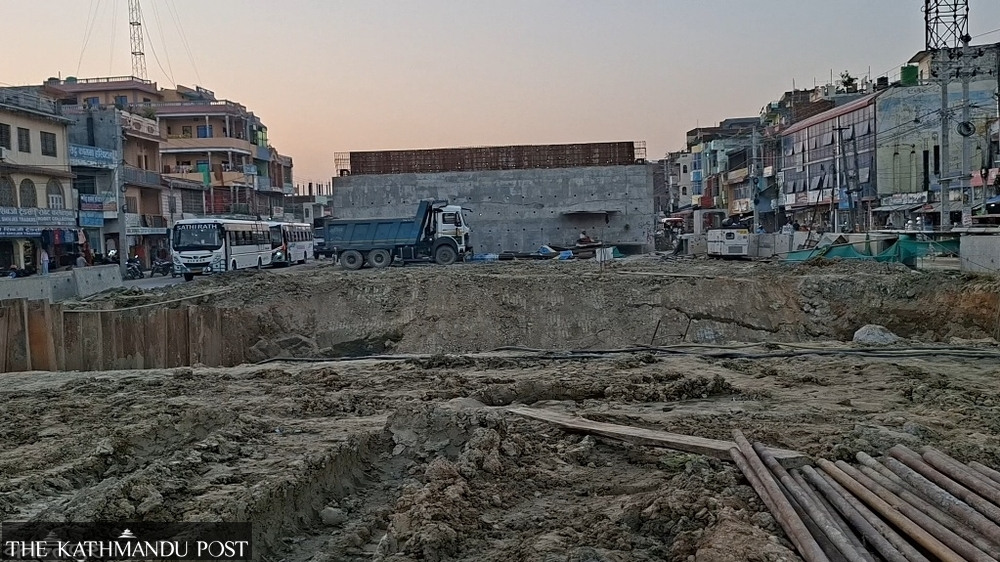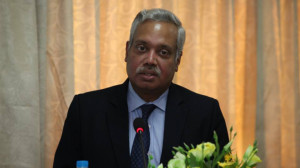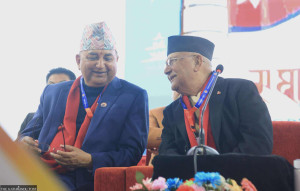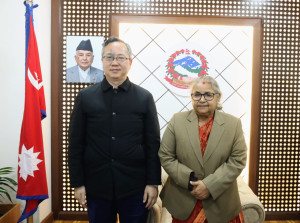National
Five years on, East-West Highway widening in Siraha and Saptari still incomplete
Dust, delays and poor coordination between agencies leave residents, travellers and businesses suffering along the Kamala–Kanchanpur stretch.
Binay Aazad
Shops along the East-West Highway in Mirchaiya, the commercial hub of Siraha, display goods on their shelves, but few customers walk in. Most who enter leave without buying. The reason is that even new goods appear old and dirty under layers of dust.
When 52-year-old Bilat Mahato of ward 13 of Lahan Municipality reached Mirchaiya on his bicycle en route to visit his daughter in Bandipur, his clothes and body were already covered in dust.
The problem extends beyond Mirchaiya—it stretches from Kamala in Siraha to Kanchanpur in Saptari. Travelling along this stretch of the highway is difficult not only because of the dust but also because the road becomes impassable after even light rainfall. Vehicles and passengers passing through are barely recognisable under thick layers of mud and dust.
This has not been a problem for a few months, but for five years. The widening of this section of the East-West Highway—from Kamala in Siraha to Kanchanpur in Saptari—has been ongoing since 2020. The pace of construction has been so slow that a project meant to finish in three years remains incomplete even after five years.

The Chinese construction company China Railway No. 2 Engineering Group was awarded the Rs15.66 billion contract on October 29, 2020. The task of widening the road into four lanes was divided into two sections. The western section runs 47.40 kilometres from Kamala to Kusaha, and the eastern section covers 39.42 kilometres from Kusaha to Kanchanpur, totalling 86.82 kilometres.
According to the agreement, the project was to be completed by October 28, 2023. When the contractor failed to meet the deadline, the government first extended the deadline to December 25, 2024, and then again to December 31, 2025. With only about two months remaining in the latest extension, nearly one-third of the work is still pending.

According to the Kamala–Kanchanpur Road Project (Western Section), physical progress stands at 67 percent. Project chief Ujjwal Shrestha said that if construction continues properly, the work could be completed by the end of the current fiscal year in mid-July.
“If the contractor works efficiently, we can finish by this fiscal year, otherwise, we cannot say,” he said. “We’ve been constantly pushing the contractor, but sometimes they face problems, sometimes we do.”
Shrestha said there are four main reasons for the delay: structures such as electric poles have not been removed from the construction site in time, riverbed construction materials remain scarce, the contractor has failed to release enough funds as committed, and Chinese workers have repeatedly faced mistreatment from locals.
He added that while local authorities began clearing the road area soon after the agreement was signed, the Nepal Electricity Authority has consistently delayed removing electricity poles. According to him, 15 poles in Lahan, 60 in Golbazar, and 21 in Choharwa are yet to be shifted.

Such problems have caused the construction to repeatedly halt and resume. The work resumed after Chhath, following a long halt due to a lack of funds released by the contractor.
“Sometimes electricity poles are not removed, sometimes there are issues with locals, and sometimes the contractor itself is slow,” said Shrestha. “Our role is mainly to coordinate, so everyone’s cooperation is essential.”
Out of the 47.40 kilometres in the western section, about 31.5 kilometres have been blacktopped. Of the 25 bridges planned, concrete work has been completed on all, with only railing and painting work pending.
An overpass and three underpasses are being built in Lahan, one overpass in Mirchaiya, and one underpass in Golbazar. Work has started on the Mirchaiya and Lahan structures, while the Golbazar underpass has been delayed as locals demanded that only one be built instead of two.
Progress in the eastern section at 64 percent
In the eastern section of Saptari, physical progress stands at 64 percent. Out of the 39.42 kilometres, around 20 kilometres have been blacktopped on both sides, said Niraj Shakya, chief of the Kamala–Kanchanpur Road Project (Eastern Section). Of the 30 bridges planned, 28 have had concrete work completed, while two are still under construction. Two underpasses are being built in Rupani, Saptari.

Dust, accidents and health risks
Delays in highway widening have made life difficult for residents and business owners alike. Once-busy markets along the highway have seen a sharp drop in trade, particularly in Mirchaiya, Lahan and Golbazar of Siraha, and several markets in Saptari.
“Customers rarely come because of the dust and mud. Those who come often leave without buying anything after seeing the condition of the goods,” said Bharat Mahaseth, a shopkeeper in Mirchaiya. “Traders are now struggling even to pay their shop rent.”
Accidents have also increased, and dust pollution has led to a rise in respiratory, skin and eye problems. Doctors warn that the pollution can cause long-term damage to the heart and brain.
“Every day, we receive accident victims and patients suffering from respiratory and eye problems due to dust,” said Dr Sarika Goit, medical superintendent at Mirchaiya Hospital. “If this continues, it will have lasting effects on people’s heart and brain health.”




 17.12°C Kathmandu
17.12°C Kathmandu














